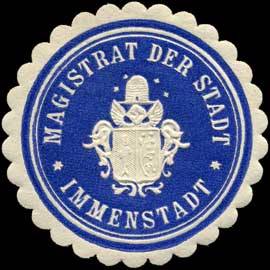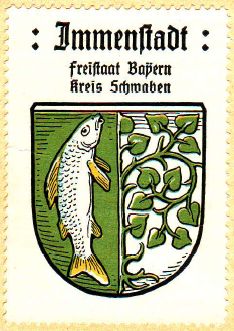Immenstadt im Allgäu: Difference between revisions
Jump to navigation
Jump to search
Knorrepoes (talk | contribs) No edit summary |
Knorrepoes (talk | contribs) No edit summary |
||
| Line 21: | Line 21: | ||
The fish symbolises the good fishing in the area. In the 18<sup>th</sup> century the shield was covered with a beehive, which is a canting symbol (Imme=bee in the local dialect). Since 1915 the beehive is not used anymore. | The fish symbolises the good fishing in the area. In the 18<sup>th</sup> century the shield was covered with a beehive, which is a canting symbol (Imme=bee in the local dialect). Since 1915 the beehive is not used anymore. | ||
{|align="center" | |||
|align="center"|[[File:immenstadtz1.jpg|center]] <br/>Seal from around 1900 | |||
|align="center"|[[File:immenstadt.hagd.jpg|center]] <br/>The arms in the [[Kaffee Hag albums]] +/- 1925 | |||
|} | |||
[[Literature]] : Stadler, 1964-1971, 8 volumes; Hupp, O: [[Kaffee Hag albums]], 1920s | [[Literature]] : Stadler, 1964-1971, 8 volumes; Hupp, O: [[Kaffee Hag albums]], 1920s | ||
Revision as of 10:54, 10 November 2012
| Heraldry of the World Civic heraldry of Germany - Deutsche Wappen (Gemeindewappen/Kreiswappen) |
IMMENSTADT IM ALLGÄU
State : Bayern
District (Kreis) : Oberallgäu (until 1973 Sonthofen)
Official blazon
Gespalten von Grün und Silber; vorne ein aufrechter, gebogener silberner Fisch, hinten eine halbe bewurzelte grüne Linde am Spalt.
Origin/meaning
Immenstadt became a city in 1463 and the oldest seal dates from the same time. It already shows the arms as they are now. The linden tree is taken from the arms of the city of Lindau, which owned several rights in the area.
The fish symbolises the good fishing in the area. In the 18th century the shield was covered with a beehive, which is a canting symbol (Imme=bee in the local dialect). Since 1915 the beehive is not used anymore.
| Seal from around 1900 |
The arms in the Kaffee Hag albums +/- 1925 |
Literature : Stadler, 1964-1971, 8 volumes; Hupp, O: Kaffee Hag albums, 1920s



